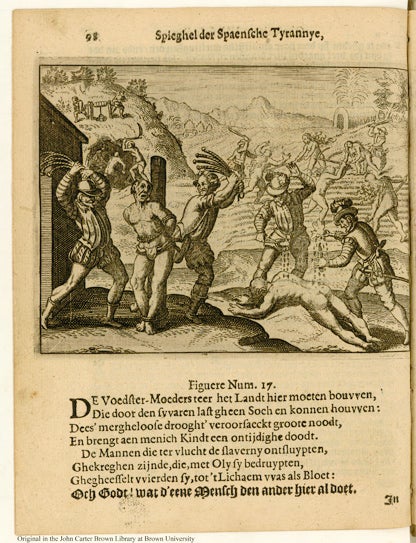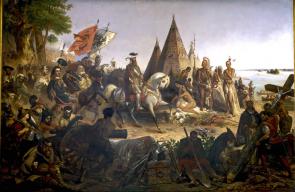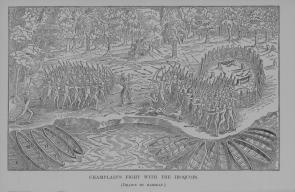Early European Imperial Colonization of the New World
by Brendan Smyth
Introduction
By the early to mid-seventeenth century, Spain, England, France, and the Netherlands were all competing for colonies and trade around the world. Beginning in the late fifteenth century, explorers, conquerors, missionaries, merchants, and adventurers sought to claim new lands to colonize. It was only a matter of time before imperial rivals butted heads over land possession and trade routes. Competition for land grabs, settlement, trade, and exploration led to the growth of New World imperialism and the economic system of mercantilism. As European nations squabbled and settled lands, much was to be lost on the side of the indigenous Americans. Native populations shifted and decreased from the time of settlement onward.
Guiding Question
Which label best describes the very first wave of European immigration to the Americas in the late fifteenth to early sixteenth centuries: explorers, missionaries, merchants, or conquerors?
Objectives
Basic-level objective: Skill set: map identification; recall; description; analysis
- Geographically, what areas of the New World were western Europeans interested in settling?
- What motivated western European powers (France, the Netherlands, England, Spain, and Portugal) to migrate and settle the New World?
Intermediate-level objective: Skill set: compare and contrast; analysis
- How did these European powers differ in their colonization plans?
- What conflicts arose over competition for land acquisitions in the New World?
Advanced-level objective: Skill set: evaluation and drawing inferences
- Which label best describes the very first wave of European immigrants to the Americas: explorers, missionaries, merchants, or conquerors?
Vocabulary: imperial; missionaries; imperialism; mercantilism; indigenous
Lesson Procedures
After the introduction and warm-up activity students will read and analyze five different types of materials: a map, three pieces of artwork, and three primary documents. They will then be asked to write a follow-up argumentative writing sample that answers the Guiding Question with support from the materials. Along the way they are to work in groups to actively support one another in the learning of the materials. Each group will have to answer questions that accompany the materials.
Preparation Instructions
Warm-up Activity: Designed to entice the students into learning about Spanish colonization.
Read Bartolome de Las Casas’s narrative: A Brief Account of the Destruction of the Indies, Seville, Spain, 1552
A full text is available here.
These People were found by them to be Wise, Grave, and well dispos’d, though their usual Butcheries and Cruelties in opressing them like Brutes, with heavy Burthens, did rack their minds with great Terror and Anguish. At their Entry into a certain Village, they were welcomed with great Joy and Exultation, replenished them with Victuals, till they were all satisfied, yielding up to them above Six Hundred Men to carry their Bag and Baggage, and like Grooms to look after their Horses: The Spaniards departing thence, a Captain related to the Superiour Tyrant returned thither to rob this (no ways diffident or mistrustful) People, and pierced their King through with a Lance, of which Wound he dyed upon the Spot, and committed several other Cruelties into the bargain. In another Neighboring Town, whose Inhabitants they thought, were more vigilant and watchful, having had the News of their horrid Acts and Deeds, they barbarously murdered them all with their Lances and Swords, destroying all, Young and Old, Great and Small, Lords and Subject without exception.
Vocabulary:
disposed: killed, dead
brutes: beast like
burthens: old form of the word burden
anguish: hardships
exultation: joy, happiness
victuals: food
diffident: shy, timid
vigilant: guarding, watchful
Display the following image from the Brown University Archive of Early American Images, also available as a PDF here.

Questions for Discussion:
- According to sixteenth-century historian Bartolome de Las Casas, how did the Spanish treat the indigenous people they encountered in the New World?
- How does the drawing in the Las Casas book display the Spanish? How does it display the indigenous people?
Lesson Activities
Differentiated Instruction 1: Geography of New World Colonization
Please use a map of the Age of Exploration outlining exploration and routes of the Spanish, English, and French (included in most texts and available online) and an atlas or modern political map to compare and contrast.
Questions for Discussion
- What modern nations did Spanish explorers sail to?
- What modern nations did English explorers sail to?
- What modern nations did French explorers sail to?
- What would motivate these Europeans to venture into unknown lands and risk death?
- How have these explorers left their mark on the areas they explored?
Differentiated Instruction 2: Using Art to Assess Spanish Exploration and Colonization
Display William Henry Powell’s Discovery of the Mississippi, 1853

This painting is in the US Capitol Rotunda and can be further studied at the Architect of the Capitol’s website.
Provide students with a basic introduction to the painting, including:
- This painting was made in 1853, three hundred years after the event portrayed.
- The main figure of this painting is Hernándo de Soto, a Spanish explorer who led the first Europeans to visit the Mississippi River and parts of southeastern North America.
Group Work and Questions for Discussion:
- Identify three figures wearing different types of clothing in this painting. Attempt to give them a job title or character title.
- What items in this painting display power?
- What items in this painting display religion?
- How can this painting relate to what motivated the Spanish to explore and colonize the New World?
Differentiated Instruction 3: Captain John Smith
A reading from Captain John Smith
Note that this is written in an older form of English, which can be discerned by having the teacher read this aloud while students read along silently.
Background Information: Captain John Smith was a late sixteenth-/early seventeenth-century Englishman who was a sailor, explorer, and colonist. His adventures in the New World and the settlement of Jamestown, Virginia, paved the way for further English colonization. This letter was published in England to entice Englishmen to migrate to the New World.
LONDON
Printed for John Tappe, and are to bee solde at the Greyhound in Paules-Church yard, by W.W.
1608
Anchoring in this Bay, twentie or thirtie went a shore with the Captain, and in coming aboard, they were assalted with certaine Indians, which charged them within Pistoll shot: in which conflict, Captaine Archer and Mathew Morton were shot: whereupon, Captaine Newport seconding them, made a shot at them, which the Indians little respected, but having spent their arrowes retyred without harme, and in that place was the Box opened, wherin the Counsell for Virginia was nominated: and arriving at the place where wee are now seated, the Counsell was sworne, the President elected, which for that yeare was Maister Edm. Maria Wingfield, where was made choice for our scituation a verie fit place for the erecting of a great cittie, about which some contention passed betwixt Capatain Wingfield and Captaine Gosnold, notwithstanding all our provision was brought a shore, and with as much speede as might bee wee went about our fortification.
I tolde him being in fight with Spaniards our enemie, being overpowred, neare put to retreat, and by extreame weather put to this shore: where landing at Chesipiack, the people shot us, but Kequoughtan they kindly used us: we by signes demaunded fresh water, they described us up the River was all fresh water: at Paspahegh also they kindly used us: our Pinnsse being leake, we were inforced to stay to mend her, till Captaine Newport my father came to conduct us away.
Vocabulary
counsel: government
Questions for Discussion
- What problems did John Smith and his crew face in exploring and settling in the New World?
- How does John Smith portray the Spanish?
- How does John Smith portray the indigenous people he encountered?
Differentiated Instruction 4: Samuel de Champlain
Image study: Deffaite des Yroquois au Lac de Champlain, 1613, published by Chez Iean Berjon, also available from the Library of Congress. This engraving depicts French explorer Samuel de Champlain’s encounter with the Iroquois at the site of modern-day Lake Champlain.

Questions for Discussion
- How does this engraving depict the indigenous people?
- Who has the military advantage according to this image? Why?
Pair this engraving with the following primary source written by Samuel de Champlain in his Memoirs of Samuel de Champlain Books I and II:
Of all the most useful and excellent arts, that of navigation has always seemed to me to occupy the first place. For the more hazardous it is, and the more numerous the perils and losses by which it is attended, so much the more is it esteemed and exalted above all others, being wholly unsuited to the timid and irresolute. By this art we obtain knowledge of different countries, regions, and realms. By it we attract and bring to our own land all kinds of riches, by it the idolatry of paganism is overthrown and Christianity proclaimed throughout all the regions of the earth. This is the art which from my early age has won my love, and induced me to expose myself almost all my life to the impetuous waves of the ocean, and led me to explore the coasts of a part of America, especially of New France, where I have always desired to see the Lily flourish, and also the only religion, catholic, apostolic, and Roman. This I trust now to accomplish with the help of God, assisted by the favor of your Majesty, whom I most humbly entreat to continue to sustain us, in order that all may succeed to the honor of God, the welfare of France, and the splendor of your reign, for the grandeur and prosperity of which I will pray God to attend you always with a thousand blessings, and will remain,
MADAME, Your most humble, most obedient, and most faithful servant and subject, CHAMPLAIN.
Vocabulary
exalted: highly honored
irresolute: undecided
idolatry: worship of idols
Lily: reference to the French symbol of royalty, the fleur de lis
Questions for Discussion
- Summarize the passage: "For the more hazardous it is, and the more numerous the perils and losses by which it is attended, so much the more is it esteemed and exalted above all others, being wholly unsuited to the timid and irresolute."
- What religious plans does Champlain wish to accomplish in the New World?
- What does the reference "I have always desired to see the Lily flourish" mean?
Differentiated Instruction 5: Charter to Sir Walter Raleigh
Note that this is written in an older form of English, which can be discerned by having the teacher read this aloud while students read along silently. This reading is a charter given to Sir Walter Raleigh. Raleigh was an English sailor and adventurer who explored and claimed land in North America for the English Crown.
Questions for Discussion
- What does this charter give Sir Walter Raleigh permission to do?
- How does this charter describe the inhabitants of the New World?
- If you were to label Raleigh’s mission to the New World, which label would it be and explain why?
Charter to Sir Walter Raleigh: 1584
ELIZABETH by the Grace of God of England, Fraunce and Ireland Queene, defender of the faith, &c. To all people to whome these presents shall come, greeting.
Knowe yee that of our especial grace, certaine science, and meere motion, we haue given and graunted, and by these presents for us, our heires and successors, we giue and graunt to our trustie and welbeloued seruant Walter Ralegh, Esquire, and to his heires assignee for euer, free libertie and licence from time to time, and at all times for ever hereafter, to discover, search, finde out, and view such remote, heathen and barbarous lands, countries, and territories, not actually possessed of any Christian Prince, nor inhabited by Christian People, as to him, his heires and assignee, and to every or any of them shall seeme good, and the same to haue, horde, occupie and enjoy to him, his heires and assignee for euer, with all prerogatives, commodities, jurisdictions, royalties, privileges, franchises, and preheminences, thereto or thereabouts both by sea and land, whatsoever we by our letters patents may graunt, and as we or any of our noble progenitors haue heretofore graunted to any person or persons, bodies politique.or corporate: and the said Walter Ralegh, his heires and assignee, and all such as from time to time, by licence of us, our heires and successors, shall goe or trauaile thither to inhabite or remaine, there to build and fortifie, at the discretion of the said Walter Ralegh, his heires and assignee, the statutes or acte of Parliament made against fugitives, or against such as shall depart, romaine or continue out of our Realme of England without licence, or any other statute, acte, lawe, or any ordinance whatsoever to the contrary in anywise notwithstanding.
Vocabulary:
preheminences: permanencies: those that surpass all others
jurisdictions: areas where law applies
